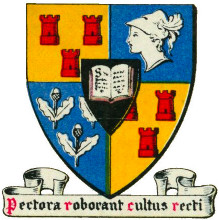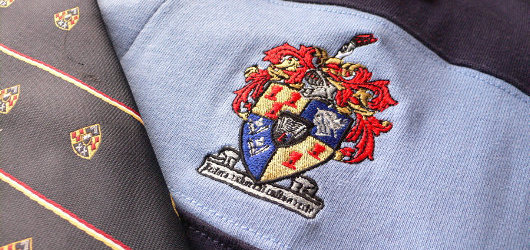
About Andrew Cusack
 Writer, web designer, etc.; born in New York; educated in Argentina, Scotland, and South Africa; now based in London.
Writer, web designer, etc.; born in New York; educated in Argentina, Scotland, and South Africa; now based in London. read more
News
Blogs
Reviews & Periodicals
Arts & Design
World
France
Mitteleuropa
Knickerbockers
Argentina
The Levant
Africa
Cape of Good Hope
Netherlands
Scandinavia
Québec
India
Muscovy
Germany
Academica
Die Wapenskild van die Universiteit

 EDUCATION IN STELLENBOSCH began as early as 1685, but it wasn’t until 1866 that the Stellenbosch Gimnasium was founded. Like the (English-language) South African College in Cape Town, the Dutch/Afrikaans Gimnasium was a school covering secondary, and tertiary education. Twenty years after the foundation of the Gimnasium, it was renamed the Victoria Kollege in honour of the Queen’s jubilee of 1887. In 1918, the Parliament of South Africa finally reorganised education in the Cape, and separated both the South African College and the Victoria Kollege into their respective secondary and tertiary parts. SAC was divided into the University of Cape Town & the South African College Schools, while the Victoria Kollege was divided into the University of Stellenbosch & the Paul Roos Gymnasium.
EDUCATION IN STELLENBOSCH began as early as 1685, but it wasn’t until 1866 that the Stellenbosch Gimnasium was founded. Like the (English-language) South African College in Cape Town, the Dutch/Afrikaans Gimnasium was a school covering secondary, and tertiary education. Twenty years after the foundation of the Gimnasium, it was renamed the Victoria Kollege in honour of the Queen’s jubilee of 1887. In 1918, the Parliament of South Africa finally reorganised education in the Cape, and separated both the South African College and the Victoria Kollege into their respective secondary and tertiary parts. SAC was divided into the University of Cape Town & the South African College Schools, while the Victoria Kollege was divided into the University of Stellenbosch & the Paul Roos Gymnasium.
Along with gaining proper status as a university, the Universiteit van Stellenbosch also adopted a coat of arms in 1918. In the language of heraldry, the University’s coat of arms (or wapenskild in Afrikaans) is described as:
The “three towers gules” come from the arms of the town of Stellenbosch, and find their origin in the personal arms of Governor Simon van der Stel who founded the town in 1679. The quartering of yellow and blue (“or” and “azure”) was also inspired by van der Stel’s arms. Minerva symbolizes learning obviously, while the oak twigs represent the magnificent oak trees planted by Governor van der Stel, many of which still grace the streets of the town. The motto, Pectora roborant cultus recti, is Latin for “A sound education strengthens the spirit/character”.
Regrettably, the university tends to use its corporate logo of a stylised ‘S’ and oak leaf instead of its splendid heraldic achievement. The arms of the university can nonetheless be found around the town, displayed architecturally on numerous university buildings, in official university publications, on student clothing, and of course on the university tie.

Search
Instagram: @andcusack
Click here for my Instagram photos.Most Recent Posts
- Gellner’s Prague December 19, 2024
- Monsieur Bayrou December 18, 2024
- Dempsey Heiner, Art Critic December 17, 2024
- Vote AR December 16, 2024
- Articles of Note: 12 December 2024 December 12, 2024
Most Recent Comments
Book Wishlist
Monthly Archives
Categories


